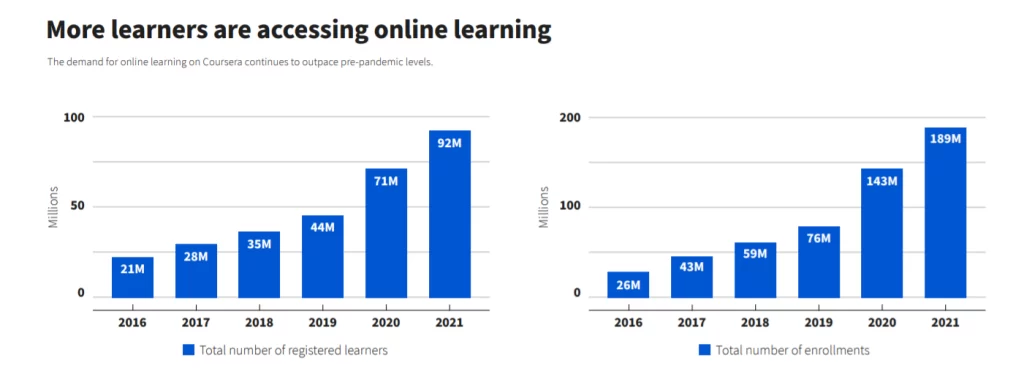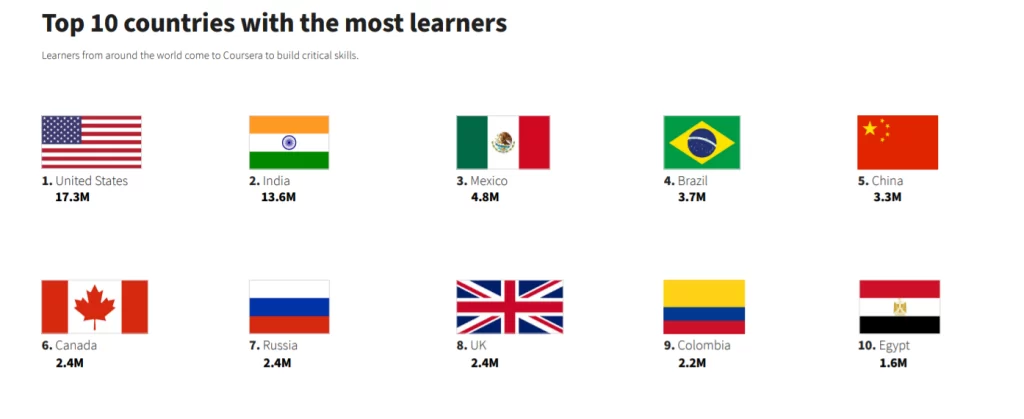Online learning has experienced enormous growth since the Internet and education converged. Both students and teachers can learn and teach from the comfort of their homes quite well by using online courses.
We simply believe that Online learning is becoming increasingly popular due to the pandemic’s imposed remote working policies for businesses, universities, and schools. However, if we examine the facts, it is already predicted that the market for online education will reach $ 350 billion by 2025.
The remote working induced by Covid-19 allows the learners to focus on online courses to acquire the necessary skills to succeed in the rapidly changing workplace of competition.
UGC Announcement: Online education is growing rapidly across the country
According to UGC Chairman Jagdish Kumar, enrollment in online courses is steadily rising, and in the upcoming future, it will pick up speed though. As per the data, the number of online students climbed by 179% over a year.
Right now, there are 345 online courses available in institutions across the nation. And about 72,400 students, including Indian and international students, are enrolled in these courses. In the previous year, 25,905 students took online classes. It has grown by 179 percent this year.
If you dive deeper, you will find 1078 programs and 86 higher education institutions with 20,37,676 students enrolled in open and distance education. And the previous year, the number of students enrolled was 14,38,101. You might see the upward trend of online learning.
Global Online Learning Growth Curve: The Upward Trend
Coursera, an online learning platform, released an impact report in 2021 which shows that more than 20 million additional students registered for online courses in a year which is way more than equal to the increase in the past three years.

This data showed that 21 million people signed up for online courses offered by Coursera in 2016, and that figure rose by almost 7 million per year for the next couple of years. And you can see the enrolment, which just doubled in 2020 as compared to its previous year due to the pandemic, and it rose by 32% the following year to reach a peak of 189 million.
This data clearly shows the huge global acceptance of online learning on a global scale.
If we talk about the online learners from different countries, we will see the highest number of learners are from the asia pacific region.

Data shows that the US came out on top with more than 17 million students enrolling in online courses. Then comes India, with 13.6 million students. Brazil and China made up the top five, with a significant margin separating these two countries from Mexico, which had almost 5 million.
Why Is Online Learning Trend Growing?
Online Learning Offers a Huge Variety Of Educational Programmes
You can find many courses created by Worldwise Experts if you search the online learning course library. Universities and other institutions of higher learning are increasingly providing online versions of their programs across various levels and fields of study.
No matter a student’s educational background, he can find every subject in online courses, from science to music, to pursue his higher studies. A legitimate certificate, diploma, or degree can be obtained through online study, which is a terrific alternative to visiting a campus in person.
High Adaptability
Online learning enables students and teachers to create their schedules for learning and teaching. There is no time or place boundation; anybody can learn anything from the comfort of their place and at their own pace.
So if anybody wants to continue working and studying together, he can easily do so with online education. Online education creates a solid work-study balance and helps in managing time effectively. The student and teacher may agree to take on greater tasks and have more freedom if they have a similar objective.
It enables a personalized learning environment.
We have already discussed how flexibility might enable you to choose your own learning pace. However, online learning is also adaptable to each learner’s unique needs and skill levels.
There are fewer students in online classrooms than in traditional ones, but this has the benefit that if a student has a problem understanding a subject or a concept, the teacher can quickly clarify it using amazing digital tools.
Additionally, many online platforms now have the capability for teachers to address each student’s issue individually.
Tutors can also incorporate additional forms like forums or debates to enrich their lessons. There is frequent access to a wide variety of content online, including videos, images, and eBooks.
Online Education Is Less Expensive Than Traditional Education
Online education is frequently less expensive than traditional classroom teaching. Students will find numerous payment methods at their convenience. They can pay in monthly installments or halfyearly, or pay per chapter.
Online programs are quite advantageous for students who cannot pay the entire tuition upfront.
In addition, many organizations also offer scholarships for online courses, which is very advantageous for intelligent students.
Students can also select their ideal teacher while at home, and transportation costs are reduced.




